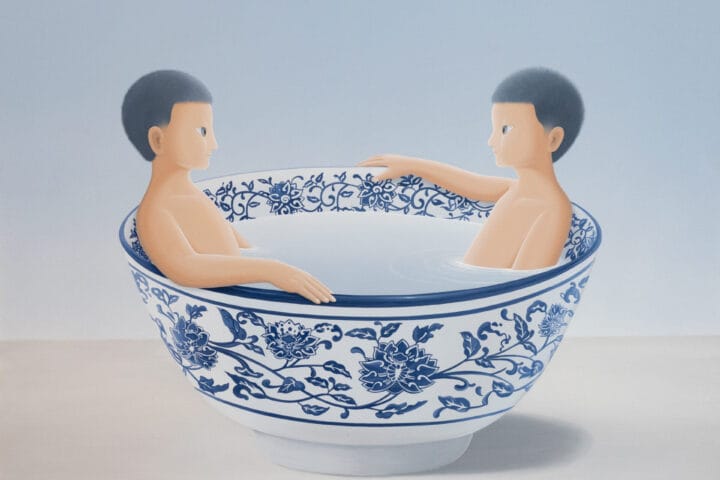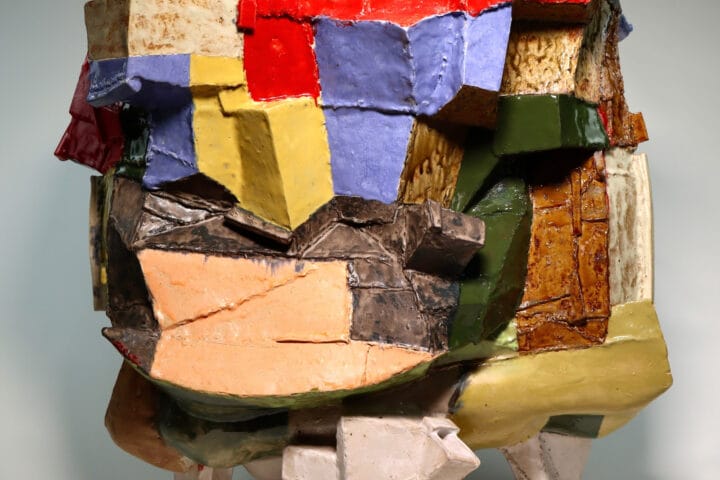David Zwirner is pleased to present concurrent exhibitions of work by Huma Bhabha (b. 1962) at the gallery’s 537 West 20th Street and 34 East 69th Street locations in New York. These are the gallery’s first presentations of Bhabha’s work since the announcement of her representation in 2022, and they follow the artist’s 2023 solo exhibition at M Leuven, Belgium, which recently traveled to MO.CO., Montpellier, France. In March 2024, three sculptures by Bhabha will be specially featured in the retrospective exhibition Julie Mehretu: Ensemble at Palazzo Grassi, Venice. In April 2024, a large-scale installation by Bhabha, commissioned by Public Art Fund, will be unveiled at Brooklyn Bridge Park, New York.
Bhabha creates layered and nuanced sculptures and drawings that center on a reinvention of the figure and its expressive possibilities. Her formally innovative practice pulls from a wide range of references, from those that span the history of art to quotidian influences such as science fiction and horror films and the makeshift structures and detritus of urban life. Instinctive and rigorous, her work brings diverse aesthetic, cultural, and psychological touchstones into contact with matters of surface, materiality, and formal construction. Featured at West 20th Street are new sculptures, varying in size from small to monumental; on view at East 69th Street are new works on paper and smaller-scale sculptures. Together,
the exhibitions highlight Bhabha’s ability to move between a wide range of media and forms, creating deeply resonant hybrid figures that seem to simultaneously dwell in the past, present, and future.
The exhibition in Chelsea comprises a grouping of figures in patinated and painted bronze or cast in iron. The works are sculpted from materials including styrofoam, cork, and clay, which the artist then carves, gouges, paints over, and otherwise marks up before casting. While distinct in appearance and size, all the sculptures in the exhibition seem to be connected by a kind of genetic thread, forming an emotional hive that resides in a shared landscape of destruction, displacement, and rebirth. A lone diminutive figure cast in bronze and painted from the neck down in styrofoam pink, What Should it Be (2024) stands like a ringmaster or liminal guide poised at the threshold of distinct physical or psychic terrains as it leads visitors into a charged zone, recalling the titular character from Andrei Tarkovsky’s science-fiction cinematic masterpiece Stalker (1979). Beyond lies a group of three cast-iron sculptures—Bhabha’s first foray into the medium—of disembodied heads and torsos laid out on concrete plinths, glowing fiery orange as they rust, as if caught in a radioactive wasteland or left for dead on the scorched surface of Mars. The cast-iron works will continue to oxidize and evolve in appearance, affirming the notion of time as a primordial sculptor’s tool—a concept that Bhabha has repeatedly returned to in her oeuvre.
Further inside are two upright figures, Maybe Nothing Maybe Everything (2024) and Nothing Falls (2024), both cast in bronze. The former presents a multiheaded creature whose arms are pressed to its chest in prayer or panic. The latter takes the form of a rectangular earthen body that surges upward from the ground—reminiscent of the unshakable monolith from Stanley Kubrick’s film 2001: A Space Odyssey (1968)—and pushes its bone-white skeletal head toward the open sky as if it is a holy relic or ritual sacrifice on a dais. As Bhabha evocatively describes, the work’s contrasting geometric and organic forms resemble “earth sculpted by wind and fire touching a cloud made of bone.”
(Huma Bhabha, in correspondence with the gallery, 2024.)
These two sculptures flank the largest figure in the show, Even Stones Have Eyes (2023), which stands more than twelve feet tall. With its shadowy Januslike faces that have been etched, scarred, and seemingly charred, this peg-legged behemoth exudes a thrilling stillness and horror as it towers over its companions like a watchful parent surrounded by its brood. At once monstrous, animal, alien, and deeply human, Bhabha’s totemic figures recall cycles of growth and decay, destruction and restoration, thereby challenging our understandings of permanence, monumentality, and personal and collective histories.
At the East 69th Street gallery, the cast-iron sculpture Waddah (2024) takes the form of a lone petrified human figure—devoid of a face or identifying features—that rests on a pedestal reminiscent of black earth. As with many of her recent sculptures, Bhabha considers the plinth to be an intrinsic part of the work, lending the overall arrangement the feeling of a mortal relic or an artifact from another world. The other sculpture on view, My Ancestor (2023), comprises a pair of amputated legs that have been sculpted out of porous cork and inscribed with lines of white chalk to resemble stump feet or cloven hooves. Hovering between states of ruin and repair, these sculptures appear either as bearers of the collective casualties forced on nature, or as signs of fresh life emerging from the earth. Juxtaposed with Waddah and My Ancestor is a suite of new works on paper, each one depicting a different head constructed from vibrant swaths and strokes of ink, acrylic, gouache, and pastel, as well as elements of collage. An enduring and crucial aspect of her practice, Bhabha’s large-format multimedia drawings beckon the viewer with their exaggerated, ghoulish visages and unabashedly confrontational gazes.
Together, Bhabha’s sculptures and works on paper are visibly marked by the human hand. With their rough-hewn surfaces, they appear to have emerged from a blasted landscape—like survivors of war, or perhaps prisoners returning home, acutely aware of those left behind. As curator Shanay Jhaveri writes, “The artist’s roving eye speaks volumes to a particular sensibility, one in which various aesthetic practices are in dialogue with one another.… There is a convergence of form and content in her work, coming from different places and histories, that seeks to question rather than affirm extant cultural dynamics.” (Shanay Jhaveri, “Acknowledging Pain: Huma Bhabha’s We Come in Peace,” in Ed Halter, Shanay Jhaveri, and Sheena Wagstaff, eds., Huma Bhabha: We Come in Peace. Exh. bro. (New York: The Metropolitan Museum of Art, 2018), p. 45.)
Born in Karachi, Pakistan, Huma Bhabha came to the United States in 1981 to attend the Rhode Island School of Design, Providence, from which she received her BFA in 1985. She later studied at the School of the Arts at Columbia University, New York, from which she received her MFA in 1989. The artist presently lives and works in Poughkeepsie, New York.
In March 2024, three sculptures by Bhabha will be specially featured in the retrospective exhibition Julie Mehretu: Ensemble at the Palazzo Grassi, Venice. In April 2024, a large-scale installation by Bhabha, commissioned by Public Art Fund, will be unveiled at Brooklyn Bridge Park, New York.
In 2023, M Leuven, Belgium, presented the solo exhibition Huma Bhabha: LIVIN’ THINGS. The show traveled to MO.CO., Montpellier, France, in November 2023 as Huma Bhabha: A fly appeared, and disappeared. A solo presentation of Bhabha’s work curated by Nicholas Baume was on view at Fundación Casa Wabi, Puerto Escondido, Mexico, from 2022 to 2023. In 2020, the Baltic Centre for Contemporary Art, Gateshead, United Kingdom, presented Huma Bhabha: Against Time. The Institute of Contemporary Art, Boston, organized Huma Bhabha: They Live, on view in 2019, and published an accompanying catalogue. The installation Huma Bhabha: We Come in Peace, was commissioned by The Metropolitan Museum of Art, New York, in 2018 for the museum’s Iris and B. Gerald Cantor Roof Garden.
Previous solo exhibitions of the artist’s work have taken place at prominent institutions such as The Contemporary Austin, Texas (2018); MoMA PS1, New York (2012); Collezione Maramotti, Reggio Emilia, Italy (2012); Aspen Art Museum, Colorado (2011); and The Aldrich Contemporary Art Museum, Ridgefield, Connecticut (2008), among others.
Bhabha’s work has also been included in numerous group exhibitions internationally, including Summer Exhibition 2023, Royal Academy of Art, London; Reclaim the Earth, Palais De Tokyo, Paris (2022); Traces, Portland Art Museum, Oregon (2022); Hi Woman (curated by Francesco Bonami), Museo di Palazzo Pretorio, Prato, Italy (2021); NIRIN, 22nd Biennale of Sydney (2020); 2019 Yorkshire Sculpture International, Wakefield, United Kingdom; All the World’s Futures, 56th Venice Biennale (2015); and the 2010 Whitney Biennial.
Bhabha has been the recipient of notable awards, such as the Guna S. Mundheim Fellowship, Berlin Prize, awarded by The American Academy in Berlin (2013); and the Emerging Artist Award, awarded by The Aldrich Contemporary Art Museum, Ridgefield, Connecticut (2008). In 2022, Bhabha was elected as a National Academician by the The National Academy of Design, New York. In 2023, the artist was inducted into the American Academy of Arts and Letters, New York.
Work by the artist is held in significant collections worldwide, including the Art Gallery of New South Wales, Sydney; Buffalo AKG Art Museum, New York; The Bronx Museum of the Arts, New York; Carnegie Museum of Art, Pittsburgh; Centre Pompidou, Paris; Collezione Maramotti, Reggio Emilia, Italy; Dallas Museum of Art; Des Moines Art Center & Pappajohn Sculpture Park, Des Moines, Iowa; Ekebergparken, Oslo; Frances Lehman Loeb Art Center, Vassar College, Poughkeepsie, New York; Hammer Museum, Los Angeles; Hirshhorn Museum and Sculpture Garden, Washington, DC; Kiran Nadar Museum of Art, Delhi; Long Museum, Shanghai; Los Angeles County Museum of Art; The Metropolitan Museum of Art, New York; Mountain Art Foundation + Frank Lin Art Center, Beijing; Museum of Art, University of New Hampshire, Durham; Museum of Fine Arts, Houston; The Museum of Modern Art, New York; Museum of Old and New Art, Hobart, Tasmania, Australia; National Gallery of Australia, Canberra; Nerman Museum of Contemporary Art, Overland Park, Kansas; The New York Public Library; Rhode Island School of Design Museum, Providence; The Roberts Institute of Art, London; Sharjah Art Foundation, United Arab Emirates; Sheldon Museum of Art, University of Nebraska, Lincoln; Tate, United Kingdom; Whitney Museum of American Art, New York; Yale University Art Gallery, New Haven, Connecticut; and the Zhuzhong Art Museum, Beijing, among others.










